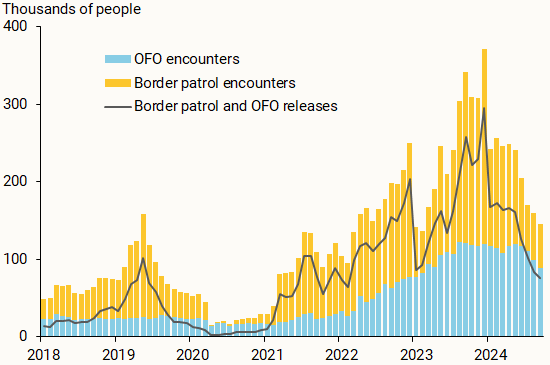U.S. net international migration (NIM) grew at historically high rates over the past several years. An update of earlier San Francisco Fed analysis (Duzhak 2024), using new and revised data on the number of immigrants entering the United States in 2023 and 2024, suggests that inflows of immigrants have slowed notably in the later months of 2024.
NIM levels fell by about 0.5 million from 2023 to 2024, though migration inflows remain about three times higher than the historical average. Updated data suggest that the slowdown is largely due to fewer undocumented immigrant entries, particularly along the southern border.
Changes to net migration estimates
International immigration is a large source of labor growth in the United States and can have important impacts on the overall economy. A reliable measure of NIM is therefore essential for understanding the extent of these effects. Several agencies provide estimates for annual NIM numbers; among those, the Congressional Budget Office (CBO) was the first to point out surging immigration in their January 2024 report.
In a recent FRBSF Economic Letter, Duzhak (2024) describes a method to estimate NIM based on combined data from different agencies. This approach closely follows the CBO methodology, specifying estimates of net migration for three categories: lawful permanent residents and eligible applicants; nonimmigrants such as students or temporary workers; and all other foreign nationals, which encompasses undocumented immigrants. Duzhak updated CBO’s estimates of inflows to reflect higher reported numbers of undocumented immigrants in late 2023 and early 2024 and showed how increased NIM modestly eased U.S. labor market tightness.
In this post, we use the most recent data from the Department of Homeland Security through September 2024 to further update the number of undocumented immigrant entries and estimates of NIM in 2023 and 2024. We estimate that NIM in 2023 was close to 3.5 million, about 200,000 higher than previously estimated by the CBO.
Furthermore, new data suggest that the sharp increase in NIM in 2023 may be subsiding more quickly than previously estimated by the CBO in January 2024. Incorporating this new data and projecting to the end of 2024 suggests that NIM levels in 2024 may be around 2.9 million, about 400,000 lower than the CBO’s projection.
The increase in NIM compared with the CBO’s estimate for 2023 is largely driven by higher numbers of immigrants in the undocumented category. Figure 1 shows how the inflow of undocumented immigrants increased throughout 2023 to a peak of around 1.1 million in the fourth quarter.
Figure 1
Inflow of Undocumented Immigrants to the United States

Source: CBO, Transactional Records Access Clearinghouse, U.S. Customs and Border Protection, and authors’ calculations.
The elevated levels were largely due to higher numbers of immigrants entering along the border, which can be classified into two types depending on where they enter. After being apprehended by the U.S. Border Patrol along an unofficial border crossing or being deemed inadmissible at official ports of entry, immigrants who meet certain qualifications are released through parole or with notice to appear before a judge. The number of people released through the Border Patrol are depicted by the light blue bars in Figure 1, while those released through the Office of Field Operations (OFO) are depicted by gold bars.
Figure 1 shows that inflows of undocumented immigrants decreased through the third quarter of 2024 from their 2023 peak. Due to delays in data updates, we assume the same number of visa overstays (dark blue bars) and undetected immigrants (green bars) in our 2024 estimates as reported in 2023. However, recently heightened security at the border might have reduced the number of illegal crossings, further reducing 2024 NIM estimates.
What’s driving the change in net immigration?
Both the increase in NIM in 2023 and the slowing of NIM in 2024 are largely driven by entries of undocumented immigrants at ports of entry and along the border. Foreigners entering at ports of entry—designated places like airports where people lawfully enter the country—are processed by the OFO, while immigrants entering between ports of entry—that is, unofficial border crossings—are managed by the Border Patrol.
Figure 2 plots the reported encounters and releases of both agencies over time (gray line). The number of encounters consistently increased throughout 2023, up to a peak of nearly 400,000 in December 2023. Since that peak, however, total encounters have declined to just above 2022 levels.
Figure 2
Undocumented Migrant Encounters and Releases

Source: U.S. Customs and Border Protection, Transactional Records Access Clearinghouse, and authors’ calculations.
These declines are almost entirely attributed to decreased encounters reported by Border Patrol along the border (gold bars). Encounters reported by OFO have remained relatively more stable (light blue bars), decreasing from around 119,000 in May 2024 to around 89,000 in September. Border Patrol reports began to decline more sharply following the June 4 Presidential Proclamation that temporarily suspended the entry of certain noncitizens across the Southern border. In September 2024, Border Patrol reported around 54,000 encounters, the lowest level since the pandemic.
The number of encounters, however, does not directly translate into undocumented migration inflows. Only a portion of migrants encountered at the border are released through parole or with notices to appear in court; the rest are deported.
The number of people released has slowed in recent months, largely driven by changes along the Southwest U.S. border. Border Patrol reported around 206,000 releases along the Southwest border at the peak in December 2023. That number dropped to 16,000 in the most recent report for September 2024, a decrease of nearly 92%. Over the same time, OFO releases along the Southwest border declined slightly, from 45,000 in December 2023 to roughly 41,000 in September 2024.
As a result, the total number of immigrants released declined, but not as drastically as the number of encounters at the Southwest border. Data from the final quarter in 2024 will reveal whether these downward trends continue or if inflows plateau at their current levels.
References
Congressional Budget Office. 2024. The Demographic Outlook: 2024 to 2054. Report, January 18.
Duzhak, Evgeniya. 2024. “Recent Spike in Immigration and Easing Labor Markets.” FRBSF Economic Letter 2024-18 (July 15).
The views expressed here do not necessarily reflect the views of the management of the Federal Reserve Bank of San Francisco or of the Board of Governors of the Federal Reserve System.



